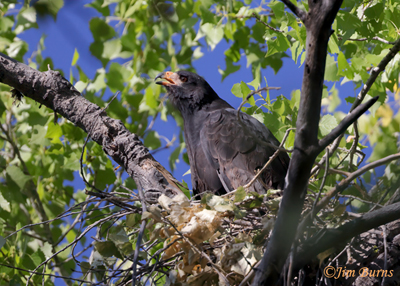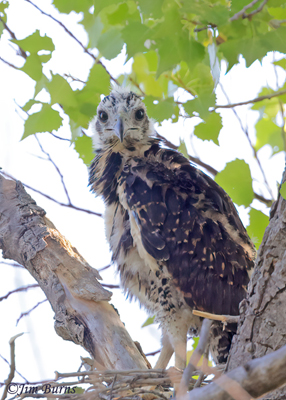
My companion on this central Arizona adventure is an old friend whose sobriquet would imply a certain confidence and comfort level in the outdoors, but he crawls out of the sleeping bag with a nervous look that implores me to close the door. I laugh and reassure him the Coyotes are not coming to breakfast with us despite how close they sound. I remind him, and myself, it is not their weird yips and wails that are unearthly here, but rather the metallic sound of the slider that is so out of place in the stillness.
For my friend and me this is a three day, two part adventure. We have a travel day, a day exploring a little known watershed looking for an uncommon Arizona dragonfly, the Pima Dancer, and then a day exploring a famous watershed looking for North America’s most unique raptor, the Common Black Hawk. The goal, of course, is serenity and good photographs of both species, but things could get complicated.
Bug and bird both inhabit free flowing streams running through Fremont Cottonwood stands, but less than 10% of this beautiful, original habitat remains in Arizona. Photography is difficult at best in these riparian corridors replete with dappled sunlight, small waterfalls, rushing ripples, and slick rock. Moreover, our southwestern monsoon rains have not yet begun, and we are enduring 90 degree overnight low temperatures under a “heat dome” attributed to global warming. What could go wrong?
The first bird I hear after the Coyotes settle down is “Cheew . . . cheew . . . cheew . . . prta, prta, prta, prta, prta.” Not being an ear birder, and with no visual, it takes me a minute before it comes to me. Our early bird is a Northern Cardinal, and then as we enjoy breakfast I begin to hear our expected and aptly named summer chatterbox. This one always takes me a minute because the so-called song is just a strange, sporadic series of chips and gurgles, often minutes on end from disparate locations—“Chut, eee, eee, eee, eee, eee, whitta, whitta, sproing”—long pauses in between phrases, but that one wiry, final note always gives away our skulking Yellow-breasted Chat.
As we finish eating the sun peeks over Casner Butte, and a group of birds lands in the tree above, serenading us with multiple sharp, loud, strident “Ta-kweers” followed by rolling pips. A family of kingbirds, parents and young of the year. I glass the closest bird looking for either a white chin patch or white outer tail feathers, but don’t see either. The bird looks scraggly though, probably one of the young, so I glance at the next one and see the white chin and light tan variation across the tail tip. A family of Cassin’s Kingbirds have come to breakfast. Better than the Coyotes, my friend says.
We find a path level with the mid story of the huge old cottonwoods rising up from the creek bed below, and we walk along the wall of the canyon until we find a game trail snaking down a steep incline to the stream. Alas, the creek is no longer flowing, but we explore the edges of several large pools that have not yet dried out under the dome of heat desiccating the entire Southwest. We find only a few odonate species and assume we are too early for the Pima Dancers which may well be dependent on the coming monsoon rains.
As we turn to head back up to our camp we hear a large bird calling, seemingly flying toward us over the vault of greenery above the fully leafed out cottonwood canopy. It is a familiar, thin, high-pitched whistle/scream, seven syllables over and over, ascending to the fourth note, then fading away. Having done my homework, I know this one in an instant, and I call Common Black Hawk to my friend even before the totally unexpected raptor, a male judging by its smallish size, drops in over the last pool and lands in a snag nearly right above us.
The habitat is right for this species, but because we hadn’t heard or seen one until now I had assumed the heat and low water levels had discouraged any Black Hawks from nesting here this year. After vocally harassing us it flies off, disappearing into the dense canopy above. Sundown is approaching as we scramble up the game trail toward camp, but halfway there we are brought up short when we hear the hawk again, much closer now that we are back on the rim at canopy level.
It takes me five minutes glassing through the thick greenery to find the calling bird, presumably the female of a pair because it looks noticeably larger than the first one. She is at eye level across the canyon, and she is . . . sitting on a nest! Two fresh, green branches in the large aggregation of dead boughs indicate this is a past nest that has been refurbished this year, but we cannot see any young birds with her. We had not expected Black Hawks here at all. Now with the creek nearly bone dry, their presence seems a bit odd. What are they eating? Are there eggs in the nest?
We speculate over dinner at what we’ve seen. Common Black Hawks are obligate riparian nesters along perennial streams, but we had assumed low water levels had precluded any breeding attempts here this year. Our best guess is this pair has started their nesting cycle anyway, very late perhaps, and the female is just now sitting on eggs. We will check the nest again at daylight, with the sunrise behind us, before moving on to our next location about an hour to the west where several pairs of Common Black Hawks are known to nest every season.
The coyotes are silent but we wake up early, refreshed despite the heat, and decide to check the nest before fixing breakfast. Halfway to last evening’s overlook we hear the female screaming at us, and we soon locate her on a snag on our side of the canyon. We take a few photos, then leave and head back to camp without checking the nest. We now know the female is not on it. But . . . why would she leave eggs for so long in this heat?
We eat and pack up, but still puzzled by what we’ve seen and heard, we walk the canyon’s rim one more time. We see or hear no hawks on the way to the nest overlook. Once there we raise the glasses and are blown away by what we see. There on the edge of the nest, all by itself, is a single chick standing almost as tall as an adult. It still has pinfeathers on its head and there is no color yet on its face or striping on its underparts. Four to five weeks old we guess, and by the appearance of its flight feathers it is not yet capable of flight. How could it not have been seen in the nest yesterday? How had we missed it?
Leaving quickly so as not to interfere with a parental food delivery, we get in the van and head west to our next stream location. As we drive we remind ourselves that both nature and its birds that we enjoy and study are immensely adaptable and, therefore, delightfully unpredictable. We know we’ll check this stream next spring. Based on this year’s trip we’ll be expecting nesting Black Hawks but no Pima Dancers. But don’t bet on either of those things. The unexpected is one of birding’s primary joys.